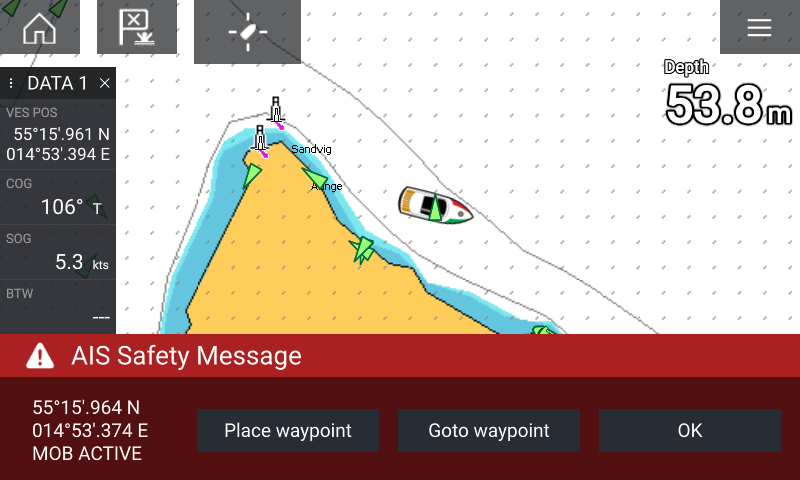July 12, 2019 New device: Alarm Button YDAB-01
If you need a hardware MOB button, or need to sound alarms from sensors or engines, or if you wish to wake up your crew from the chart plotter screen or a mobile phone, this device is for you!
We have smart sensors that can turn on or off digital switching channels depending on temperature, humidity or atmospheric pressure. However, in most scenarios we felt the lack of a sound alarm. What to do if the sensor has already turned on the pump to change the water in the live well, but the temperature is still rising? Of course we must warn the crew!
We are proud to present the world's first NMEA 2000 sound alarm module which can be managed with standard NMEA 2000 PGNs from all modern chart plotters and is open for integration with commercial and DIY projects.
The Alarm Button is a "music box" with 28 pre-recorded sound signals: horns, whistles, tone signals, etc. From the NMEA 2000 point of view, it is a binary switch bank with 28 channels. However, unlike our Circuit Control, the channels are not relays that are switching loads. When you turn on the channel, the Alarm Button will play the corresponding sound signal. It has a 10W audio amplifier inside, so it is loud enough!
You can also start or stop the sound playback from a screen of a modern MFD or even from mobile device or laptop using Web Gauges, available in all our Wi-Fi products. Just press the virtual button on your chart plotter to ask the galley for another cup of coffee or mojito. If you need to add more physical buttons in different locations connected to NMEA 2000, this can be solved with the Switch Control.
This is only one of the three possible functions of this device! It can act as MOB button also. What can you do, if you have no chart plotter in the cockpit and the helmsman needs to place a MOB mark urgently (on the MFD in the saloon) or wake up your crew in an emergency? Even if you have a chart plotter in the cockpit, offshore racing rules may require a hardware MOB button, which is absent on many modern popular MFDs like Raymarine Axiom or B&G Vulcan.
The solution is our new device. Press the button, and it will place the MOB mark on all MFDs on the vessel (see the screenshot above) and wake your crew with a sound alarm. It emulates EPIRB with AIS VHF support, but does not send any data outside the vessel.
And last, but not least: if you are rent out your boat, you may need to alarm the helmsman when revolutions are too high over a long period of time (5 minutes, for example) or engine that the temperature is too high (plastic bags or weeds on the water intake?). Or you may need to sound NMEA 2000 alarms sent by the engine gateway or control unit. For instance, a surveyor may set this requirement or an engine's buzzer may be too quiet or is broken. This is the 3rd function of the Alarm Button - it can perform engine monitoring or sound engine alerts.
Of course, it has a lot of settings! Basic settings can be configured from the connected button: you can change the mode (MOB button, digital switching unit or engine monitoring) and adjust the sound volume. To modify other settings, you can use any NMEA 2000 gateway (for example, from Yacht Devices, ActiSense or Maretron). An NMEA 2000 gateway is required to configure user alarms in engine monitoring mode, for example. To update the firmware, you will need one of our NMEA 2000 USB or Wi-Fi gateways and routers.
In the next update we will add uploading of user sounds over the CAN network, so you will be able to record "All hands on deck!" using a most terrible voice, and your crew will jump out of their beds in seconds with one click.
To learn more about the Alarm Button, visit the product's page. The product is supplied with NMEA 2000 Micro Male or SeaTalk NG connectors and is already available for order at USD $149. The stainless steel button with an integrated LED is supplied with the device, the sound speaker is not supplied with the device and must be purchased separately (standard 4 or 8 Ohm 10W speaker is required).
Next articles:
- July bug fixes, AIS in Navionics / July 8, 2019
- Trigonometry and encryption in the Bridge / July 1, 2019
- Pressure sensor, updates for Engine Gateways / May 24, 2019
Previous articles:
- Anchor alarm with Bridge and Button / July 17, 2019
- All hands on deck! / August 9, 2019
- August updates / August 23, 2019
See also: recent news, all news...

